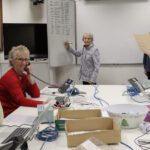The Murchison Widefield Array (MWA) has recorded a key milestone in its ongoing development, with the building and deployment of equipment for its Phase Two expansion now complete.
 In an operation that has taken nearly 16 months, 128 new antenna stations have been assembled on the MWA site by a team of MWA operations staff, students from Curtin University and international project partners, as well as Geraldton contractors GCo Electrical.
In an operation that has taken nearly 16 months, 128 new antenna stations have been assembled on the MWA site by a team of MWA operations staff, students from Curtin University and international project partners, as well as Geraldton contractors GCo Electrical.
This latest addition to the Curtin University-led MWA, brings the total number of antenna stations onsite at its remote location in Western Australia’s mid-west region, to 256.
Project Director, Curtin University Associate Professor Randall Wayth, said the new antennas have significantly increased the research capacity of the $50 million radio telescope, further boosting WA and Australia’s role in understanding the origins of the first stars and galaxies in the Universe.
“By doubling the number of antennas, and quadrupling the size of the area they are distributed across, the telescope is now ten times more powerful in its exploration of the evolution of the Universe, with an ability to discern details twice as fine as previously,” Associate Professor Wayth said.
“What this means is not only can we explore more of the Universe, but the sensitivity and quality of the images we receive is also vastly improved.
“We have already started receiving data from the new antennas including sharper quality images from the giant radio galaxy Fornax A. We are hugely excited about what’s in store as we continue to search and explore with the expanded array capabilities,” Associate Professor Wayth said.
The Phase Two rollout began in mid-2016 with the deployment of 72 tiles, arranged in a regular hexagonal configuration that became operational in October last year.
The remainder of the rollout – 56 additional long baseline tiles – began at the start of this year with contractors and MWA staff joining forces to lay each antenna by hand between July and October.
“Our mandate for this expansion was to leave as small a footprint as we could on the site of the MWA out of respect for the landscape, and in cultural recognition of the land’s custodians, the Wajarri Yamatji people,” Associate Professor Wayth said.
“This meant everything was done on foot and by hand to ensure minimal impact, and that where we could, the antennas were placed in areas already clear of bush. It was a huge people-based effort.”
The MWA is one of four precursor telescopes for the much larger billion-dollar Square kilometre Array (SKA) and the only one that is fully operational.
Chair of the MWA Board and Board Member of the SKA, New Zealand Radio Astronomy Professor Melanie Johnston-Hollitt, said the increased data and image processing capacity of the newly expanded MWA is invaluable.
“This upgrade not only increases the capability of the MWA in all of our science cases, but will also greatly add to our understanding of what’s to come on an even grander scale with the rollout of the SKA,” Professor Johnston-Hollitt said.
“Key science, engineering and computing components for the SKA are being tested by the MWA. The closer it is in size to the SKA the better our knowledge will be.”
MWA Project Scientist, Associate Professor David Kaplan from the University of Wisconsin-Milwaukee, said the improved scientific capabilities of the wider MWA cannot be underestimated.
“Improving our understanding of the time when the first stars and galaxies were turning on is one of the highest goals in cosmology research. It’s a period of the Universe we know very little about, so having the increased capacity of 128 new antennas to build on the work already being done is critical to our search,” Professor Kaplan said.
The Phase Two expansion of the MWA was partly funded by a $1 million grant as part of the Australian Research Council (ARC) Linkage Infrastructure, Equipment and Facilities (LIEF) scheme. A further $1.2 million has been provided by partner institutions.
For more information on the MWA expansion and science cases please visit the MWA website.



